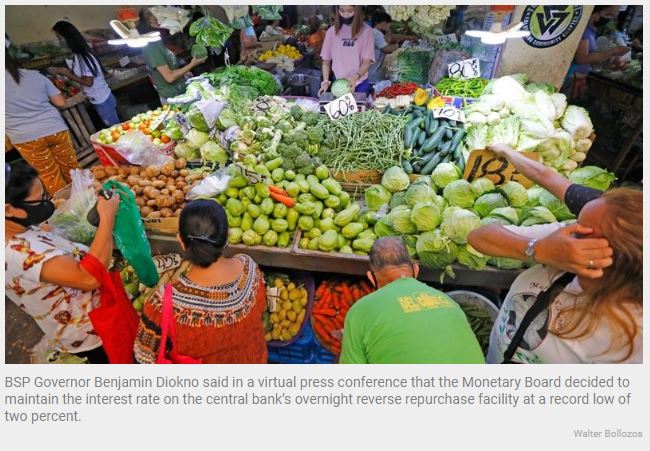Philippines: Interest rates stay low, but inflation a concern
MANILA, Philippines — The Bangko Sentral ng Pilipinas (BSP) left interest rates untouched yesterday, as widely expected, but the window for accommodation to support sustained economic recovery is closing fast as authorities flagged inflation risks due to possible second round effects from rising global oil prices.
BSP Governor Benjamin Diokno said in a virtual press conference that the Monetary Board decided to maintain the interest rate on the central bank’s overnight reverse repurchase facility at a record low of two percent.
Interest rates on the overnight deposit and lending facilities were likewise kept at 1.5 percent and 2.5 percent, respectively.
The central bank has kept interest rates at record lows for 10 consecutive monetary policy meetings, or since November 2020 when it last delivered a 25-basis-point cut.
“On balance, the Monetary Board deems it prudent to maintain the BSP’s accommodative policy stance, given a manageable inflation environment and emerging uncertainty surrounding domestic and global growth prospects,” Diokno said.
The BSP chief also said domestic economic recovery has continued to gain traction on the back of the government’s ongoing vaccination program and the easing of mobility restrictions.
But Diokno warned that elevated global commodity prices, heightened geopolitical tensions, and the uneven pace of vaccinations across countries could dampen the outlook for global economic recovery.
“Looking ahead, given the stronger signs of recovery in output growth and labor market conditions and improvements in domestic financial markets, the BSP will continue to carefully develop its plans for the eventual normalization of its extraordinary liquidity measures when conditions warrant, in keeping with our price and financial stability mandates,” he said.
According to Diokno, the inflation projections have slightly increased, reflecting the impact of higher domestic food inflation and global oil prices.
“The risks to the inflation outlook continue to lean slightly toward the upside for 2022 but remain broadly balanced for 2023,” Diokno said.
The BSP chief reiterated that the implementation of non-monetary measures to ensure adequate supply of key food commodities should be sustained in order to mitigate supply-side pressures on inflation.
Diokno pointed out that the increased volatility in international oil prices warrants close monitoring and appropriate interventions when necessary in order to arrest potential second-round effects.
BSP managing director Zeno Ronald Abenoja said the Monetary Board raised its inflation forecasts to 3.7 instead of 3.4 percent for 2022 and to 3.3 from 3.2 percent for 2023, but these remain manageable and within the government’s two to four percent target.
Abenoja attributed the upward revisions in the forecasts to higher global crude oil prices as well as non-oil prices that could affect domestic inflation.
He said global oil prices are now expected to average $83 per barrel or $10 higher than the $73 per barrel used in setting the forecast last December.
Authorities expect global oil prices to ease going forward on expectations of higher supply.
On the path of the consumer price index (CPI), the BSP official said inflation is seen accelerating above the two to four percent target in the second quarter, before easing back to within the range in the second quarter this year until next year.
Abenoja said domestic economic activity continues to gain traction, but downside risks remain elevated due to the lingering effects of the pandemic with the emergence of the more contagious Omicron COVID-19 variant.
“Over the medium term, the economy is seen to reach the pre-pandemic level by the third quarter of 2022,” Abenoja said.
ING Bank senior economist Nicholas Mapa took note of Diokno’s tone on the planned normalization.
“This is the first time Diokno has made mention of his exit strategy this year and suggests that a potential rate reversal is being considered,” Mapa said.
He said Diokno also mentioned that the economic recovery is gaining traction although monetary authorities admitted that downside risks to the growth outlook remain.
“The BSP also indicated that policy normalization may begin after notching four quarters of GDP growth. Thus, we believe that the trigger point for a potential rate reversal would have to be linked to a solid economic recovery coupled with depreciation pressure on the peso,” Mapa said, adding that the Dutch financial giant expects a rate hike toward the end of the second quarter.
Michael Ricafort, chief economist at Rizal Commercial Banking Corp., said the policy rates would still likely be maintained at record lows in the foreseeable future, or for as long as necessary, in view of the need to maintain accommodative monetary policy to fundamentally support and sustain economic recovery prospects.
However, Ricafort said the US Federal Reserve has become more hawkish recently as it has signaled more and earlier rate hikes, after doubling the pace of tapering bond purchases.
“Going forward, any potential hike in the local policy rate would likely follow any Fed rate hikes from 2022-2024, that could start in the latter part of 2022, with the start of Fed rate hike as early as March in view of the need to maintain comfortable interest rate differentials with the US and other developed countries,” Ricafort said.
Source: https://www.philstar.com/business/2022/02/18/2161518/interest-rates-stay-low-inflation-concern


 Thailand
Thailand




